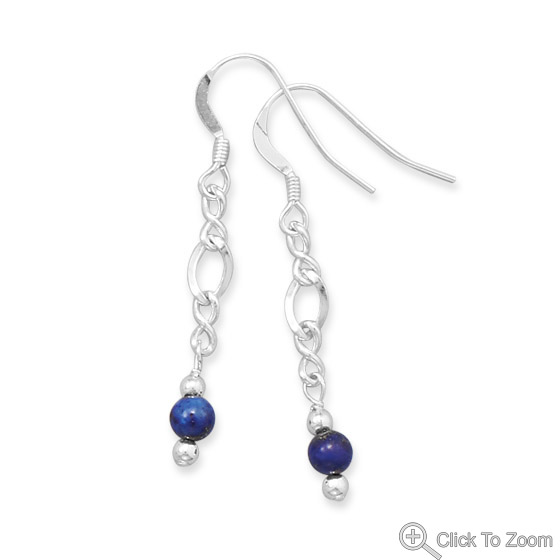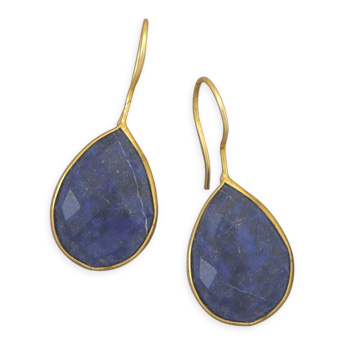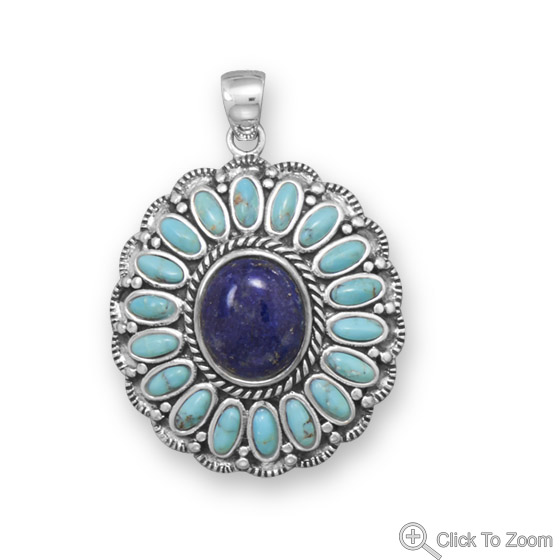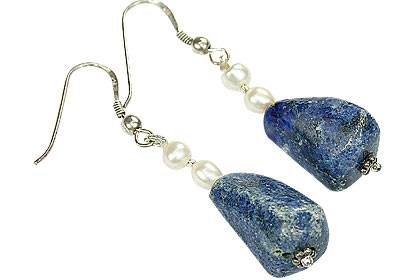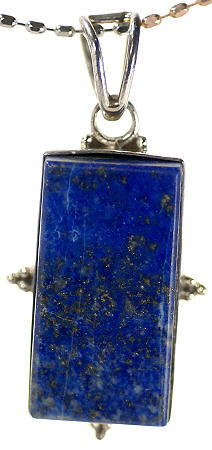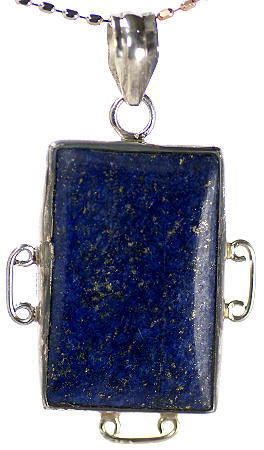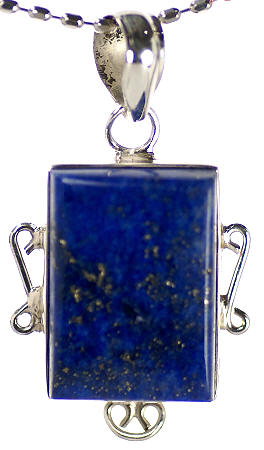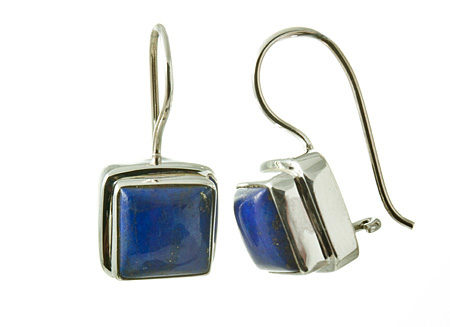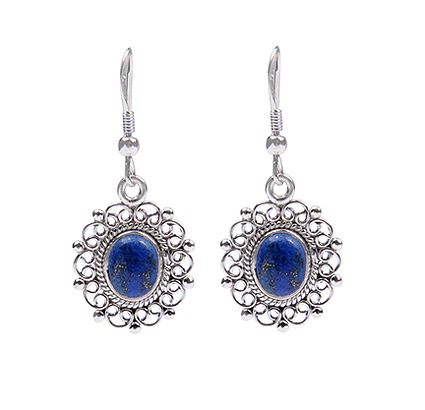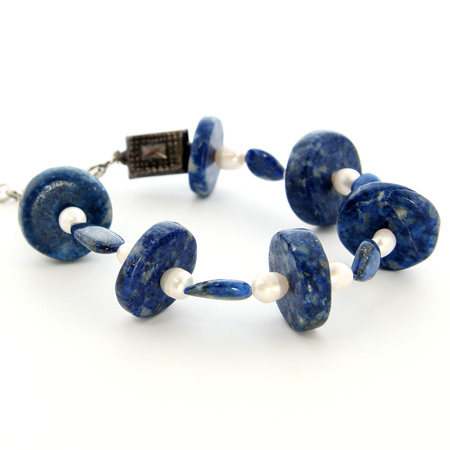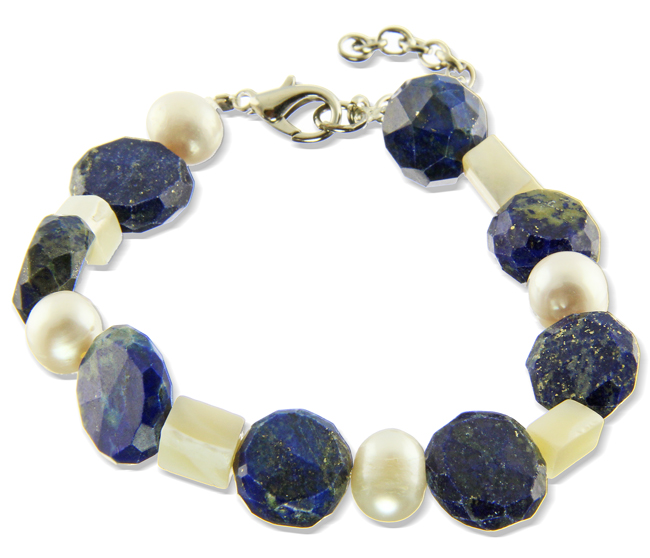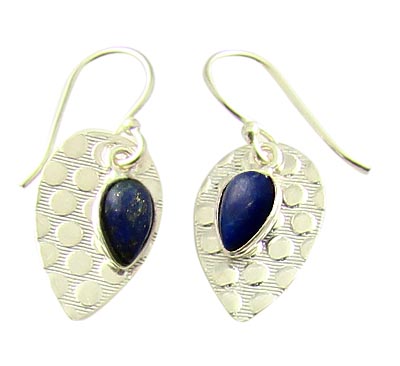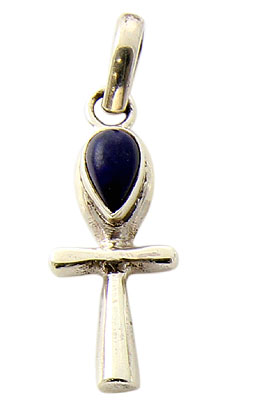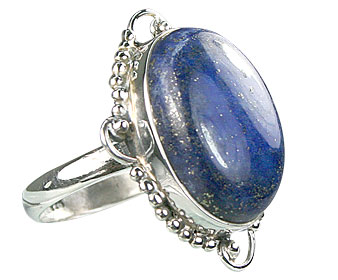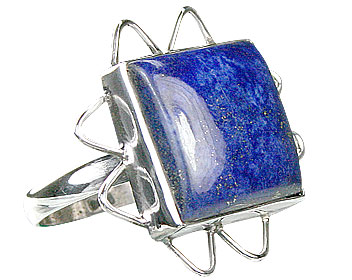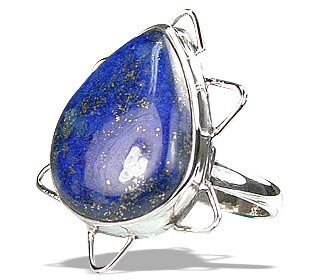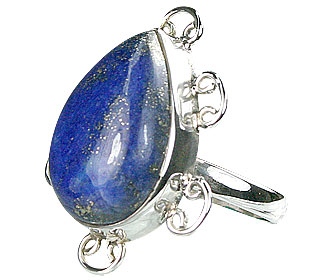Shipped Worldwide
YOU HAVE ACCESSED THE OLD WEBSITE.
PLEASE CLICK HERE TO GO TO THE NEW WEBSITE
 lapis lazuli home
lapis lazuli home
 lapis lazuli necklaces
lapis lazuli necklaces
 lapis lazuli bracelets
lapis lazuli bracelets
 lapis lazuli rings
lapis lazuli rings
 lapis lazuli earrings
lapis lazuli earrings
 lapis lazuli pendants
lapis lazuli pendants
 lapis lazuli beads
lapis lazuli beads
 All Categories
All Categories
| ||
|
|
More about #titlecase(subcat)# :
Agate was discovered with the Stone Age man in France 20,000-16,000 BC. Agate was highly valued by ancient civilizations, such as the Egyptian. The Agate industry grew up centuries ago in the Idar-Oberstein district of Germany, where agates were abundant. Agate is one of the gemstones used in Commesso, also called Florentine Mosaic. Commesso is a technique of fashioning pictures with thin, cut-to-shape pieces of brightly colored, semiprecious stones, developed in Florence in the late 16th century. Agate derives its name from the Greek "Agate??" – meaning happy. According to another theory the word Agate comes from the Achates River in Sicily, now known as the Drillo River, which still remains a major source of this stone.
Agate comes in a variety of beautiful colors, ranging from transparent to opaque. The stones can be artificially stained to produce combinations of color more vivid than those found in the natural state. Agate has irregular, sometimes circular bands of color and often replaces fossil wood. Agates are identical in chemical structure to jasper, flint, chert, bloodstone, and tiger-eye, and are often found in association with opal.
Agate is the stone for self-expression, creativity, health and good fortune. It soothes emotions and pain, sensitizes and attunes senses and helps to develop powers of eloquence, self-confidence and public-speaking. It is believed to be of special benefit to athletes and to those taking any kind of examination or test – mental or physical. This stone also works directly with the nervous system to alleviate physical tension and is said to assist in the treatment of arthritis, skeletal conditions, and as an aid to digestion.
Important sources of agate are Russia (Ural mountains), Brazil, Egypt, Germany, India, Italy, Madagascar, Mexico, Uruguay and the USA (Oregon, Washington, Idaho, and Montana).
Purple color has long been considered a royal color so it is not surprising that Amethyst has been so popular through the history. Fine amethysts are featured in the British Crown Jewels and were also a favorite of Catherine the Great and Egyptian royalty. There are evidences that around 3,000 B. C. in Egypt and in anterior Asia were made jewels of Amethyst. The Amethyst is perhaps as popular today as it was in ancient times.
The finest quality Amethyst is medium in tone, vivid in intensity, and reddish purple to bluish purple in hue. Heating removes the color from amethyst or changes it to the yellow of citrine. Most commercial citrine is made in this manner. Amethyst is the most valuable transparent, coarse-grained variety of the silica mineral quartz. It contains more iron oxide Fe2O3 than any other variety of quartz, and experts believe that its color arises from its iron content. All forms of quartz (including amethyst) are piezoelectric, making for important applications in electronics. Tourmaline is the only other gemstone that possesses this property.
Amethyst is associated with spiritual awareness, meditation, balance, psychic abilities, inner peace, healing and positive transformation. Keep it under your pillow to cure insomnia and develop intuitive powers. Also relieves stress and brings calmness in times of grief. It is said to Protect against blood diseases, toxic effects of substances, acne, neuralgia and fits.
Amethyst is mined in Brazil, Uruguay, Sri Lanka, Siberia, Canada, India, Bolivia, and Argentina and some African countries. Zambia is a significant source for Amethyst. Generally, amethyst from South America tends to be available in larger sizes than African amethyst but amethyst from Africa has the reputation for having better, more saturated, color in small sizes. Very dark amethyst, mostly in small sizes, is also mined in Australia.
Ancient Egyptian tombs are full of Carnelian jewels, because of the Egyptians’ belief that Carnelian is powerful in the path to the Afterlife. According to their system, amulets of Carnelian proved helpful in ensuring a soul’s safe passage into the next world. In more modern times, Goethe attributed the powers of Carnelian to provide protection against evil, of continuation of hope, comfort and good luck. The blood-red varieties were greatly valued by the ancients, who produced beautiful engravings in carnelian and used them as ‘seals’. Buddhists in China and India created amulets inlaid with Carnelian, ascribing to those amulets the powers of protection and utilizing them for many rituals.
Carnelian is a translucent form of the silica mineral known as ‘Chalcedony’, which is a variety of quartz. Carnelian ranges in color from yellow or reddish-brown to a deep red. When it grades into brown it is known as Sard. When it contains bands of white, it is known as Sardonyx. Chemically, Carnelian is composed of Silicon Dioxide, SiO2, and gets its red color from Hematite (Iron Oxide-FeO2) impurities.
Carnelian is associated with emotional warmth, creativity, reproduction, rebirth, reincarnation and past life recall. It is said to be an excellent motivator in matters of business and career-choices. Carnelian directly works on lower chakras, so it is believed to dispel arthritis, rheumatism, lower back troubles, female reproductive problems, increases fertility and cures impotence.
Most Carnelian found in the market is actually stained Chalcedony from Brazil or Uruguay. The finest Carnelian, however, is found in India and Arabia.
Citrine is a gemstone which has been used in Greece since the Hellenistic period (end of the 4th to the end of the 1st century BC). The name citrine is derived from the French word citron, which means lemon.
Citrine is found in pale yellow to orange in all of its glorious golden and yellow colors. The yellow color is from the presence of iron, and the darker the color the higher the grade. SiO2 Citrine is transparent, coarse-grained variety of the silica mineral quartz. Citrine is a semiprecious gem that is valued for its yellow to brownish color and its resemblance to the rarer topaz. Natural citrine is rare compared to amethyst or smoky quartz, and both of these are often heated to turn their natural color into that of citrine.
Citrine is a stone of success, prosperity and regeneration. It Induces confidence and optimism in family and business relationships. Attracts self-worth, activates mental powers, flushes emotional blocks and opens up a new lease of life. The stone not only helps acquire wealth but maintain it, because it vibrates to prosperity in all its forms. Physically, it aids digestion and eliminates toxins from the endocrine and digestive systems. Improves poor circulation, tissue regeneration, and fortifies immune system. Also good for those wearing glasses or contacts, as Citrine improves visual ability.
Citrine is found in Brazil, Madagascar, Spain, Uruguay, Scotland, USA (California, Colorado, North Carolina, Georgia, and Nevada) and Russia. Brazil is the main source of citrine.
Fluorite is one of the more famous fluorescent minerals. Many specimens strongly fluoresce, in a great variation of color. The word "fluorescent" is derived from the mineral Fluorite. The name of the element fluorine is also derived from Fluorite.
Fluorite or Fluorspar, is a mineral composed of calcium fluoride (CaF2), the principal fluorine-bearing mineral. It occurs as cubic, isometric crystals and cleavable masses. When pure, fluorite is colorless and transparent, or translucent with a glassy luster. It often occurs with impurities which are usually hydrocarbons that make it yellow, blue, purple, green, rose, or brown. The hydrocarbons, and thus the coloring, can be removed from a specimen by heating. Several varieties exhibit fluorescence. The mineral is usually found either in pure veins or associated with lead, silver, or zinc ores. It is common in limestone and dolomites and is occasionally found as an accessory mineral in pegmatites and other igneous rocks.
Flourite is associated with enlightenment and healing on all the three planes – spiritual, mental and emotional. It diminishes stress and aids in spiritual awakening. Cleanses, balances and focuses energies on all levels of chakras. On the physical body, it heals ailments of bones. Alleviates arthritis, strengthens bone tissue especially teeth enamel and relieves dental disease. It is believed to be an ancient cure for cancer. It also responds well to hormonal balance and hormonal changes like PMS, menopause.
Exceptionally clear crystalline fluorite is mined in Cumberland and Derbyshire, England. Commercially important deposits in the United States occur in a region on the Ohio River that includes parts of Illinois and Kentucky.
Garnets were so called by the ancient Greeks since color reminded them of the pomegranate seed or granatum. One of the worlds most ancient gems, garnet has been treasured for thousands of years. Use of garnets as gems is traced to the Nile Delta in 3100 B.C. Garnets since ancient times were used widely as an abrasive. Garnets are said to have been used by Asiatic tribes in place of bullets. During the latter part of the 19th century, garnet bracelets and brooches were particularly popular. The hardness of garnets and their sharp fracture make them suitable as abrasives for wood, leather, glass, metals, and plastics. Garnet varieties have become known by misleading names, frequently consisting of a locality with the name of another mineral variety, such as Uralian emerald or Cape ruby.
The versatile garnet comes in a virtual rainbow of colors, including pink, red, purple, orange, yellow, violet, green, colorless, occasionally black, brown and many shades of red and green. The most common color of garnets is reddish brown. Bohemian Garnet is deep red gemstone, Russian Demantoid and African Tsavorite are vibrant green. Garnets basiclly belong to the family of Pyropes whose chemical composition is Mg3Al2[SiO4]3. Garnets are a group of common silicate minerals that have similar crystal structures and chemical compositions. The best known type of garnet is red semi-precious stone pyrope, one of several red gems, which the ancients used to call Carbuncles. Garnets are actually one of the largest families of gemstones. Most natural garnets are mixtures of two or more of the following pure species: pyrope, almandine, spessartine, uvarovite, grossular, andradite.
The name Iolite is derived from the Greek "los", meaning violet. It was also known as the Vikings compass, due to its ability to determine the direction of the sun on overcast days. When the legendary Viking mariners sailed the wide ocean, they used thin pieces of iolite as the worlds first polarizing filter. Looking through an iolite lens, they could determine the exact position of the sun, and navigate safely. The natural mineral has little commercial use.
Iolite (also called Dichroite or Cordierite) is a transparent, violet-blue, light blue, blue, rich blue-violet stone. It is a blue silicate mineral that occurs as crystals or grains in igneous rocks, only as a result of contamination of the magma by aluminous sediment. Its chemical composition is Magnesium Aluminum Silicate (Mg2Al3O). Iolite has a rather extraordinary optical property. The gemstone changes colors depending upon which angle it is viewed from.
Iolite is a highly revered stone in the Ayurvedic tradition. One of the best stones for activating the third eye and crown chakras. Stimulates psychic awareness and promotes accuracy in intuitive pursuits. Enhances leadership ability, power, inner strength, self-confidence and executive ability.
Most of the Iolite available today comes from Sri Lanka, Burma, India, Madagascar and Brazil. Precambrian deposits of the Laramie Range, (Wyoming, USA) contain more than 500,000 tons of Iolite.
The name jasper is derived from the Greek word iaspis. In ancient writings the term jasper was chiefly applied to translucent and brightly colored stones, particularly chalcedony, but also was applied to the opaque jasper. Jasper was known as the great "rain-bringer" in the fourth century. For thousands of years, black jasper was used to test gold-silver alloys for their gold content. Rubbing the alloys on the stone, called a touchstone, produces a streak the color of which determines the gold content within one part in one hundred. Jasper is one of the gemstones, that used in commesso, also called florentine mosaic.
Jasper exhibits various colors, but chiefly brick red to brownish red. It owes its color to admixed hematite, but when it occurs with clay admixed, the color is a yellowish white or gray, or with goethite, a brown or yellow. Often jasper is found multi-colored. Chemically SiO2 , Jasper is opaque, fine-grained or dense variety of the silica mineral chert. Jasper has a dull lustre but takes a fine polish. Its hardness and other physical properties are the same as those of quartz.
Jasper is a wonderful supporting stone. Wear it to gain a positive outlook. Attracts what one needs (not wants). Good for those needing more organizational abilities. Mood elevator, invigorating, stabilizing and helps overcome depression. Useful in overcoming disorders of blood, digestion, stomach, biliousness and bladder trouble.
Jasper is common and widely distributed, occurring in the Urals, North Africa, Sicily, France, India, Venezula Germany, and in USA.
The name lapis comes from word ‘Pencil’ in Spanish. Lapis Lazuli with deep azure blue color, often flecked with golden pyrite inclusions, was treasured by ancient Babylonian and Egyptian civilizations and often worn by royalty. Lapis lazuli was widely used by Egyptians for cosmetics and painting . Persian legend says that the heavens owed their blue color to a massive slab of Lapis upon which the earth rested. Lapis Lazuli was believed to be a sacred stone, buried with the dead to protect and guide them in the afterlife.
Lapis Lazuli (also called Lazurite,) occurs in various shades of blue with some qualities being speckled with white calcite and some with yellow pyrite. The finest Lapis Lazuli is even blue color with little or no veining from other elements.. The source of the pigment ultramarine, Lapis lazuli is not a mineral but a rock containing sodalite, colored by lazurite. Because lapis is a rock of varying composition, its physical properties are variable.
One of the most powerful and energetic stone associated with the ‘Third Eye’ (6th Chakra), Lapis Lazuli must be used cautiously. People can feel dizzy or overwhelmed by its sheer energy. It is the stone of mystery, positive magic and psychic ability. Helps understand mind, expand your viewpoint and change your perception of reality. Consequently, it is a highly spiritual stone and should be used during meditation. Heals emotional wounds, cleanses the aura, develops the powers of mind, intuition, wisdom and memory. Hang it near your heart in necklace, and feel the mind and heart connected. Medically, it prevents fits, epilepsy, strokes, depression, and helps heart, spleen besides improving eyesight.
The main supplies of Lapis Lazuli are found in the Afghanistan, Egypt, Canada, Chile, the US, and South America.
Malachite derives its name from Greek word malakos meaning soft. According to another theory the word malachite comes from Greek malhe, which means grass. Mining Malachite began as early as 4000 BC by ancient Egyptians. In the New Stone Age came the discovery of extracting certain metals from the ores. Probably the first such material to be used was malachite, which easily reduced to copper in a strong fire. It led to the search for other metallic ores, and to the development of metallurgy.
Malachite is an opaque, banded stone, the colors in the bands range from a very light green to almost deep green. It is a semi-precious stone and also a valuable copper ore, hydrous copper carbonate [Cu2CO3(OH)2 ] It is responsible for the green color of tarnished copper and bronze. Because of its distinctive bright green color and its presence in the weathered zone of nearly all copper deposits, malachite serves as a prospecting guide for that metal. Malachite has been used as an ornamental stone and as a gemstone.
Malachite brings harmony into ones life and attracts money. This stone is a deeply cleansing emotional body stone and is used to release negative/painful emotions, protects against psychic attacks and others negativity. It absorbs this negativity and should be cleansed after each session. It can bring things out that are buried within someone. Malachite is also about change, and it is a great stone for those who do not like change in their lives, because it allows for an easy transition to take place. It relieves any congestion in the body and helps with confusion and lack of purpose and insecurity. It is helpful in the treatment of rheumatism, immune, and also in regularizing menstruation. Used in the treatment of asthma, toothache.
The most important mine is in Zaire. Notable occurrences are in Ural, Siberia, France, South Australia, Namibia and USA (Arizona).
In the Middle Ages, Bloodstone (sometimes also called Blood Jasper in the trade) was attributed special powers as the spots were thought to be the blood of Jesus Christ. It was used in sculptures representing flagellation and martyrdom. Bloodstone is a green stone with red spots which resemble drops of blood, so it is received its name due to this similarity.
Bloodstone also occurs in shades of dark green with red, brown and multicolored spots. The iron minerals cause the deep red and brown colors. Bloodstone is actually a dark-green variety of the silica mineral known as Chalcedony, which has nodules of bright-red Jasper distributed throughout its mass. Polished sections therefore show red spots on a dark-green background. Its physical properties are those of quartz.
Bloodstone is associated with courage, abundance, purification and good fortune.
It is said to renew relationships and love life. It is also said to provide vitality, boost talent, organizational abilities and charitable instincts. It is believed to help in curing psychosomatic illness and pains. Other healing actions it is credited with are purification of blood, and detoxification organs especially liver, kidneys, bladder and spleen.
Bloodstone is found in India (Kathiawar Peninsula), Australia, Brazil, China, and the United States.
Hematite or Haematite (as it also sometimes known as,) derives its name from the Greek word haem (blood ) in allusion to its red color. Ancient Egyptians used hematites as ornamental objects placed inside their tombs. Red ochre was used by prehistoric artists in their cave paintings.
Hematite is an ore of iron, composed of Iron oxide or Fe2O3. Hematite is a silvery, shiny opaque stone that almost looks like metal. Hematite is heavy and relatively hard oxide mineral, that constitutes the most important iron ore because of its high iron content (70 percent) and its abundance. Hematites occur in opaque red or red-brown.
A natural ferric oxide and iron-ore, Hematite possesses exceptional grounding abilities. Helps you be at ease and keep nervousness at bay. Also a protective stone, whenever you feel the need for protection and face challenge in panicky situation, carry a Hematite stone with you. It could be crucial meetings, interviews or legal matter. On a spiritual plane, it enhances astral projections, promotes balance, focus, convergence and concentration of energy. Medically, it is good for kidneys and heart – for high BP patients it reduces rapid pulse; helps coagulation and purifies blood.
The most important deposits of hematite come from a sedimentary deposit: the Lake Superior district in North America. Other important deposits include Minas Gerais (Brazil), Cerro Bolivar (Venezuela), Labrador, and Quebec.
Moonstone has derived its name from the resemblance to the color of moon. Moonstone was very popular with the Romans, who thought it was formed out of moonlight, and used it in Roman jewelry since 100 AD. In India moonstone is considered a sacred stone to this day.
Moonstones come in a variety of colors, ranging from colorless to white, gray, brown, yellow, orange, green, or pink. Clarity ranges from transparent to translucent.
One of the most beautiful stone, moonstone exhibits a mysterious shine of the moonlight and is the sacred stone of the moon goddess. It stimulates knowing, appreciation, nurturing, mothering, selflessness, sensitivity and humanitarian love – all qualities of the feminine moon goddess. People use it for problem solving and decision making and as a protective stone when you sleep with it. For physical healing, Moonstone is essentially for female health. Reduces excess fluid in body and alleviates swelling due to it; most beneficial for pre-menstrual troubles as it balances hormonal and menstrual cycles of women.
Moonstone is found in Brazil, European Alps, India, Madagascar, Mexico, Myanmar, Sri Lanka, Tanzania, and USA (Pennsylvania and Virginia). Sri Lanka produces the highest quality moonstones.
Jade was used in ancient times for weapons, utensils, and ornaments. Jade has always been prized by the Chinese and Japanese as the most precious of all stones, and the most beautiful specimens of carved jade in the form of ornamental pieces, such as vases, bowls, tablets, and statues, many of which are now museum pieces, were made in China.
Jade is a compact, opaque gemstone ranging in color from dark green to almost white. The term is applied to specimens cut from the minerals jadeite and nephrite.
Jadeite, the less common and more highly prized of the two minerals, is a silicate of sodium and aluminum, NaAl(SiO3)2, usually containing some iron, calcium, and magnesium. It belongs to the group of minerals called pyroxenes.
Nephrite, a member of the amphibole group of minerals, is a silicate of calcium and magnesium, with a small amount of iron replacing part of the magnesium. It is a tough, compact variety of the mineral tremolite.
In ancient Egypt and even now in Japan & China, Jade is considered the most precious of all stones. It is credited with five qualities: clarity, courage, justice, wisdom and modesty. It is one stone that oozes tranquility. So much so, even holding a Jade in your hand may cause you to experience a feeling of serenity or wisdom. Use Jade to reduce tension in your life. Physically, cures kidney problems, bladder troubles, poor digestion and eye problems. Alleviates sore back or spine.
Jadeite is found chiefly in eastern Asia in Myanmar, as well as in sections of Tibet and southern China. This Jade is exported to China, where it is carved into gems and figures. This Jade is known as "Chinese Jade". Chinese Jade has a higher market value than Jade from other locations. "Mexican Jade" is Jade from the large deposits in Guatemala and Mexico. This Jade was also mined since the earliest of times, but does not have such a rich history as the Chinese Jade. "Russian Jade" is a leek-green variety found near Lake Baikal in Russia. Elsewhere it can be found in Alaska, Mexico, New Zealand, Siberia, Turkistan and a, San Benito Co., California
Moss Agate is essentially Agate itself, only possessing moss like color. Its origin and history are therefore the same as that of Agate.
Moss Agate, also called mocha stone is a cryptocrystalline mineral (chalcedony) characterized by dendritic, or treelike inclusions of Hornblende. The inclusions form when manganese dioxide (MnO2) separates out during the solidification of the siliceous gel, of which all agates are composed. The dendrites are usually dark green or brown, and are best seen when the grayish white translucent agate is cut cabochon and then highly polished.
Moss Agate aids in communication with the plants, animals and all of nature. Moss Agate is associated with fertility of plants, protection of the earth, rain, prosperity, abundance, healing, restoration and creativity. Helps to improve self esteem and emotional balancing. It’s a good prosperity stone. Moss agate is said to cleanse the emotional body and release anger and frustration. This stone is helpful when starting new friendships or when seeking a compatible lover.
Important sources of moss agate are Russia (Ural mountains), Brazil, Eygpt, Germany, India, Italy, Madagascar, Mexico, Uruguay and the USA (Oregon, Washington, Idaho, and Montana).
The discovery that pearls could be cultivated in freshwater mussels is said to have been made in 13th-century China, and the Chinese have been adept for hundreds of years at cultivating pearls by opening the mussels shell and inserting into it small pellets of mud and returning the mussel to its bed for about three years to await the maturation of a pearl formation. Cultured pearls of China have been almost exclusively blister pearls. The production of whole cultured pearls was perfected by the Japanese. The research that led to the establishment of the industry was started in the 1890s by Mikimoto Kokichi, who, after long experimentation, concluded that a very small mother-of-pearl bead introduced into the mollusks tissue was the most successful stimulant to pearl production. Cultured pearls closely approximate natural pearls.
The color of pearls varies with the mollusk and its environment. It ranges from black to white, with the rose of Indian pearls esteemed most. Other colors are cream, gray, blue, yellow, lavender, green, and mauve. Cultured pearls are being produced in virtually every color of the rainbow. When a foreign particle penetrates the mantle, the cells attach to the particle and build up more or less concentric layers of pearl around it. Irregularly shaped pearls called baroque pearls are those that have grown in muscular tissue. Pearls that grow adjacent to the shell are often flat on one side and are called blister pearls. The more perfect its shape (spherical or droplike) and the deeper its lustre, the greater its value. The surface of a pearl is rough to the touch. Pearls come in a wide range of sizes. Those weighing less than 1/4 grain (1 pearl grain = 50 milligrams = 1/4 carat) are called seed pearls. The largest naturally occurring pearls are the baroque pearls; one such pearl is known to have weighed 1,860 grains. Cultured pearl is natural but cultivated pearl produced by a mollusk after the intentional introduction of a foreign object inside the creatures shell.
Pearl is the mother stone. Fosters motherly love and is a protective stone. Pearls are said to redress mental disturbance, endow maternal bliss, grant success in education, and also give access to property and vehicles. The stone redresses gastric disorders, asthma, cough, eye trouble, breathing trouble as also lung disorders.
The finest Oriental pearls are found in the Persian Gulf. Other notable sources of fine-quality pearls include the Gulf of Mannar between India and Sri Lanka, the waters off Indonesia, the Gulf of California, the Gulf of Mexico, and the waters of the Pacific coast of Mexico
Peridot has been adored since ancient times and has been valued for centuries. People in the Middle Ages wore peridot to gain foresight and divine inspiration. Legend has it that pirates favored peridot to protect them against evil. Peridot was greatly prized by Egyptian Kings. Some of Cleopatras emeralds were in fact peridots.
Peridot (also called Chrysolite) is a stone with a sparkling pale green color. It occurs in lime, yellowish green, olive green or medium dark green hues. Chemically composed of Magnesium iron silicate[Mg,Fe] 2SiO4; Peridot is a gem-quality transparent green olivine.
One of the Joy stones, Peridot brings the energies from in the aura to the physical body. Can be used to cleanse and stimulate the Heart and Solar Plexus chakras. It inspires healing, renewal, purification, rebirth and growth. Heals hurt feelings, helps mend damaged relationships. Peridot, as well as being recommended as a cure for insomnia, is said to aid the digestion, placate the nervous system, reduce temperature, improve bruised eye, and alleviate anger, jealousy and irritation.
Peridot is found in Australia, Brazil, China, Eygpt, Burma, Pakistan, Norway, and USA. Peridot has been mined from St Johns Island in the Red Sea for over 3500 years. In 1994, an exciting new deposit of Peridot was discovered in Pakistan, and these stones are among the finest ever seen.
The Greeks had originally named Quartz, Krystallos, the word for ice, but this soon came to mean any crystal. The gem varieties of quartz have been used as gemstones and other ornamental objects for thousands of years. In China’s Ming Dynasty, Quartz often showed up as stone in jewelry work. In Pre-Columbian America, explorations of Mixtec graves have uncovered Quartz use for ear jewelry. Smokey quartz is often incorrectly called Smokey topaz. The Assyrians and ancient Romans were among the first to use Rose Quartz.
Quartz, second most common of all minerals, composed of silicon dioxide, or silica, SiO2. It is distributed all over the world as a constituent of rocks and in the form of pure deposits. It is an essential constituent of igneous rocks such as granite, rhyolite, and pegmatite, which contain an excess of silica. Quartz is also common in massive forms, which contain particles ranging in size from coarse-grained to cryptocrystalline (grains invisible to the naked eye but observable under a microscope). The luster in some specimens is vitreous; in others it is greasy or splendent (shining glossily). Some specimens are transparent; others are translucent. In the pure form, the mineral is colorless, but it is commonly colored by impurities.
Quartz crystals exhibit a property called the piezoelectric effect, that is, they produce an electric voltage when subjected to pressure along certain directions of the crystal. Because of this property, quartz crystal has important applications in the electronics industry for controlling the frequency of radio waves. It also has the optical property of rotating the plane of polarized light and is used in polarizing microscopes.
Clearly, the best all purpose stone! The symbol of elemental wholeness, containing the four elements of creation. It releases the higher consciousness and develops mystical and spiritual gifts. It is also particularly useful for meditation and when working to contact or align with ones higher self! Protects against harmful electrical vibrations. Assists the wearer to think intuitively.
Quartz is one of the most abundant compounds found in the Earth’s surface and in most sedimentary, metamorphic and igneous rocks, and therefore, it and its many varieties come from thousands of locations around the globe. Quartz was even found on Moon during lunar explorations! Large deposits of good quality clear quartz have been found in Brazil, France (Dauphine), USA (Arkansas). Elsewhere, quartz also occurs at Australia, British Columbia, Germany, India, Japan, Madagascar, Malagasy Republic, Man, Mexico, Namibia, Pakistan, Sri Lanka and St. Gotthard, Switzerland.
Sodalite is named in reference to its sodium content.
Physical and Chemical Properties: Sodalite is a deep, rich blue stone with white inclusions typically occurring in nepheline, syenites and related rocks. It is composed of chloric sodium aluminum silicates (Tectosilicates, Sodalite Group – Na4Al3Si3O12Cl). Sodalite rarely forms crystals (dodecahedrons). It has poor cleavage and is uneven to subconchoidal fracture, therefore making it brittle. Soluble in hydrochloric and nitric acids, it also fuses fairly easy.
Sodalite protects from external negative energy and is a highly grounding stone. If you use computers too much, wear it to shield against damaging effects of the radiation. Sodalites color symbolizes wisdom and psychic activities. Fosters rational thinking, logic, intelligence, emotional balance, intuition, higher knowledge, clarity, truth and perception. Helps to eliminate confusion, change habits and stimulate ones intellect. Physically, it lowers blood pressure and balances the metabolism.
Rich blue masses are found near Bancroft, Ontario. Thinner veins of blue sodalite are found in nepheline rocks on the Ice River, British Columbia. Litchfield, Maine, yields sodalite in smaller masses of moderate richness. Brazil seems to be today’s major producer.
Tiger eye, (also called crocidolite cats-eye or African cats-eye) shows bands that resemble an eye of tiger, so it received its name due to this similarity. Roman soldiers wore tigers-eye for protection in battle. Tiger Eye was thought to be all seeing due to its appearance.
Tiger eye has a rich yellow and golden brown stripes, with a fine golden lustre when polished. It is basically a variety of crystalline quartz formed by alteration of an asbestos mineral (it being replaced by silica) known as crocidolite. When tiger eye is viewed in reflected illumination, a ripple or band of light, resembling a cat’s eye, follows the original fibrous structure of the asbestos. Tiger eye displays chatoyancy (a vertical luminescent band like that of a cats eye – French chat – ’cat’).. Tiger eye typically has lustrous alternating yellow or brown bands.
Tigers eye is a solar plexus stone, and helps by deepening perception and clarity of self, and giving us courage when we need it most. It is good for manifesting of ideas and to place visualizations into reality. t is claimed that tigereye will counteract feelings of hypochondria and the onset of psychosomatic illness and will also give a feeling of self-confidence. It is aso associated with the correct use of power, courage, grace and the ability to see clearly and without illusion. Excellent for asthma patients.
The largest deposits of tigers eye are in South Africa, Australia, Burma, India and the United States. The best stones come from Griqualand West.
Tourmaline came from the Sinhalese name of turmali or tormally (multicolored). For centuries it was known by the name Shrol. Colored crystals were imported from Sri Lanka at the beginning of the 18th century. Used as a gem for over 2,000 years.
Tourmaline is borosilicate mineral of complex and variable composition. The colored varieties, when transparent and free from flaws, are cut as gems. Another peculiarity of tourmaline is that crystal when heated acquires an electric charge and attracts small objects such as hair or small pieces of paper. In addition to its use as a gem, tourmaline is employed in pressure devices because of its piezoelectric properties. It has been used in depth-sounding apparatus and other devices that detect and measure variations in pressure.
The colored crystals of tourmaline are very strongly dichroic – i.e., they are of different color when viewed in the direction of different axes. Plates cut parallel to the vertical axis of a tourmaline crystal allow only the extraordinary ray through; if two such plates are placed in crossed position, the light is entirely blocked. A pair of these plates form a very simple polarizing apparatus known as tourmaline tongs.
Comes in various colors and hues. Balances, protects, calms, gives self- confidence and cheerfulness. Useful for meditation. Protects wearer against misfortune and anemia. Prevents lymphatic disease. Promotes clear verbal expression, dissolves mental friction, emotional constriction. Carries a high electrical charge and if rubbed briskly one end becomes positive and one negative, the energy can then be directed wherever peaceful energy is required. Watermelon/Pink Tourmaline is a heart balancer.
Tourmaline is found in Africa, Brazil, Madagascar, Mexico, Myanmar, Namibia, Sri Lanka, and USA (southern California, Connecticut, Maine, New York and Texas). The Isle of Elba is famous for pink crystals tipped with black which are known as Moors Heads.
The name turquoise undoubtedly comes from turc (Turkish in French) as it was transported to Europe through Turkey. Turquoise is blue, it is among the oldest known gemstones. Turquoise was in use even before 4000 BC! The Aztec of Mexico commonly used turquoise for their fine mosaic art and introduced the stone to the surrounding areas, where it became known as Chalchihuitl.
It graced the necks of Egyptian Pharaohs and adorned the ceremonial dress of early native Americans. A very special stone indeed, Turquoise is a sacred stone to many American Indian tribes and has been used in various jewelry items.
The color of turquoise ranges from sky blue through various shades of green to greenish and yellowish gray. The sky-blue variety of turquoise, commonly referred to as robins egg, is the form most desired for jewelry. When excessively exposed to sunlight or heat, this variety may become dehydrated and turn green. Turquoise is opaque except in the thinnest splinters, and has a feeble, faintly waxy lustre. Turquoise is opaque and cryptocrystalline mineral composed chiefly of hydrated copper and aluminum phosphates [CuAl6(PO4)4(OH)8*4H2O]. It is a secondary mineral deposited from circulating waters, and it occurs as granular veins running through a host rock.
Turquoise is a very sacred stone used for centuries by the Native Americans in all healing work. Increases protection, meditation energy, wisdom, balance, honest communication, strength, friendship and love. It is said that turquoise will grow pale on a sickly person and recover its color when returned to a healthy person. Overlaps the heart and throat energy centers and connects the three upper and three lower chakras. Beneficial for the entire body, especially the respiratory and immune systems It is good for laryngitis and nervousness in speech Can strengthen entire anatomy and helps improve all diseases.
Principal deposits of blue turquoise are located in Neyshabur (Nishapur), Iran. Other varieties are found abundantly throughout Western Turkistan; Egypt, including the Sinai Peninsula; and Mexico. In the U.S., the mineral is worked extensively in the area of Santa Fe, New Mexico, and in parts of California, Nevada, and Arizona.
Pink jewelry can be made from real stones such as pink sapphire, rose quartz, pink agates, rubies, or synthesized stones, and pink plastic crystals. Synthesized stones could be synthetic lab created sapphire or pink cubic zirconia / american diamond. There are also pink shade real fresh water pearls, with same quality, texture and shine as marine pearls. We at semiprecious.com have pink jewelry in roe quartz, pearls, and pink cubic zirconia (a sapphire look alike)

Monthly Newsletter
For latest products and information
Browse New Jewelry
Social Networks
Why Semiprecious?
This is why 30,000 customers prefer Semiprecious:
- 18,000 Designs
- Authentic Gemstone & Sterling Silver
- Affordable
- Great Customer Service
- Easy returns
- Secure Payments
